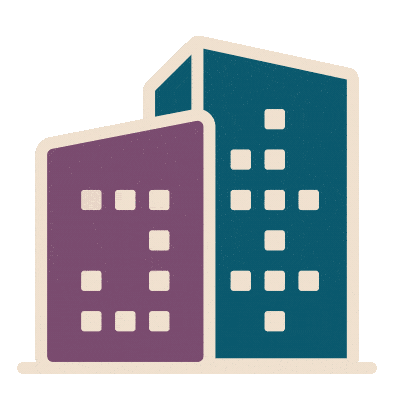WELL AP Sharon Hollingsworth: "well designed spaces endure time and bring joy"
Learn how Sharon Hollingsworth uses her expertise as a WELL AP to make mindful choices as an interior designer.
As an interior designer and WELL AP, Sharon Hollingsworth understands that spaces can be created to bring joy to their occupants. The expertise gained through and represented by her WELL AP credential helps her design spaces that facilitate people’s health and well-being.
1. What’s something about the WELL AP—or the WELL movement in general—that isn’t often discussed, but you think deserves more attention?
Before WELL, there was a ‘WELL-minded’ community looking for the opportunity to connect. There are people around the world who have had ideas on how to improve the built environment by bringing health and well-being deeper into the discussion. Previously separated or working in small groups, the formalized WELL movement has made us stronger together with a common language that turns shared and new ideas into unified action.
Meanwhile, a day in the life of a WELL AP is diverse and interesting and so much more than scorecard keeping. When thinking of WELL as an international hub that encourages dialogue around health and well-being, the WELL AP can be thought of as the local representative for the movement. We are responsible for introducing the project team to WELL, especially in markets where WELL is developing. The project team expands far beyond what may be considered typical aspects of design, to include human resources, facility managers and sustainability consultants. Along with a full comprehension of WELL, a basic understanding of consultant areas is useful to translate their expertise into WELL’s requirements. This keeps us on our toes, initiating quick shifts to different sections of the standard. What’s reassuring is that IWBI provides great support throughout the process and listens to feedback. You feel like you are part of growing WELL.
2. What’s something about the WELL AP program that you wish you’d known when you were first starting out?
The WELL AP program itself is straightforward and accessible. For example, IWBI makes continuing education simple and enjoyable by offering free webcasts that enable us to learn about standard developments while contributing to credential maintenance.
3. For people on the fence about WELL AP, what would you say to them?
Consider that WELL offers well-rounded knowledge that will be useful in your everyday life, not just in your career.
4. What led you to pursue the WELL AP credential? What personal/professional significance does the WELL AP hold for you?
Lead Up to WELL AP Credential
A respect for nature, along with an interest in science, was initially channeled into a career as a microbiology technologist in the pediatric hospital setting. Later, I earned a bachelor’s degree in interior design just as the field of green building was emerging, enabling me to join skill sets from seemingly contrasting careers.
Several years into my practice, I noticed a discouraging pushback against green building. Around this time, I was diagnosed with breast cancer. The next 2 1/2 years of treatment and recovery offered time to regroup, and I came to realize that there was no way I could give up on all things green. And this was before I knew that with WELL, the best was yet to come in the next stage of the green movement. I was drawn to WELL as a platform that enhances health and well-being, and I joined the WELL community in July 2016 as a WELL AP. Other rating systems are needed and useful, but before WELL, something had been undoubtedly missing.
Personal / Professional Significance
The WELL AP credential shows that I can guide teams through WELL, and it is also a symbol of how I practice interior design. This is about mindful choices with an awareness that well designed spaces endure time and bring joy, with the belief that everyone has the right to a healthy environment, in the home, in the workplace and outdoors.
5. What does well-being mean to you? How do you incorporate well-being into your life and routine?
Well-being Meaning to Me
Well-being to me is about making healthy connections on various levels. That means considering how we impact ourselves, each other and the planet. For example, we can stop to correlate the food we eat with not only its flavor and nutritional value for us, but with where and how it is grown and how the food, its transport, its packaging impact other people, animals and the environment. Rather than being an inconvenience, this habit can simplify choices and bring more meaning and health to life. Paying attention to these connections creates awareness that enables decisions that can contribute to positive results for the well-being of many, especially in this time when so much needs healing. Becoming reacquainted with our inherent connection to nature is key to well-being and overall life satisfaction.
Well-being in Life & Routine
Maintaining the holistic view described above is one way I incorporate well-being into my life and routine. Yet, focusing on getting through the next task can make it hard to slow down, so bringing attention back through walks, tai chi and gardening is helpful for me. I have followed a plant-based diet for over 25 years and believe this keeps me energized. Even when busy, staying in touch with family and friends and taking time to be in nature are very important. Recently, an episode of Rick and Forrest Hanson’s “Being Well” podcast on being more and doing less really spoke to me. After all, it’s well-being not well-doing.
6. Is there a specific WELL concept, feature or set of features that have really resonated with you and that you’ve incorporated into your own life?
This question is difficult, because I appreciate how WELL ties it all together and integrates so much good. But, leaning back into my microbiology background, I like how W08 Hygiene Support: Part 3 Support Effective Handwashing points out that sink/lavatory clearances and splashes matter. I plan to continue to spread the word on this one, as it appears to be an overlooked part of sink specification that doesn’t need to be restricted to hospital design.
7. From a health and well-being perspective, what are some of the most inspiring or exciting trends you’re seeing in the design industry?
Across sectors, I see overdue and inter-related wake up calls. This includes increased cultural awareness, climate crisis recognition and more openness to conversations about mental well-being. Another summer of extreme forest fires is a reoccurrence that should make ignoring our climate crisis impossible. My hope is that these events will encourage more people to examine and act on what we can do to change our direction. Humbly looking to Indigenous people for environmental leadership can act as a means of building reconciliation, while potentially offering another pathway to help both people and planet. I had the privilege to be raised near ocean and rainforest on the ancestral and unceded territory of the lək̓ʷəŋən (lay-kwung-gen) and W̱SÁNEĆ (weh-saanich) peoples and am inherently grateful for their ongoing knowledge and stewardship. My gratitude is now coupled with renewed humility as I learn a more truthful history and recognize more fully the health disparity, environmental racism and other social problems rooted in colonial processes.

8. Any tips for people studying for their WELL AP exam?
After receiving multiple requests about the WELL AP exam from local professionals and students, in the summer of 2017, I prepared a summary based on my own experience. Now that so much information is available from IWBI and especially since the exam has changed since I wrote, my tips are general.
- Respect your individual study practices by keeping in mind what type of learner you are (e.g., visual or auditory) and when and where you learn best.
- As much as we may like to conserve paper, this is one of those times where a hard copy may be beneficial to absorb the content in a different way and take a break from screens.
- Make use of the available study guides and practice tests. Watch a few WELL webcasts if you haven’t already.
9. Tell us about your experience working as a WELL AP during the COVID-19 pandemic. What are you most looking forward to post-pandemic?
Working as a WELL AP during COVID confirmed that remote WELL administration is possible and efficient. But, to me, this is best balanced with occasional in-person meetings where we can connect better. Here at home, we are having a taste of post-pandemic life and it’s amazing. Hugs and real time with friends and extended family are at the top of my list of things I am enjoying the most. In the first days of opening up after our 3rd wave, the kind of silly perma-smiles on people I passed all over the city made my similar smile even wider.
Get started on your WELL AP journey by learning more about the program and what it has to offer.







